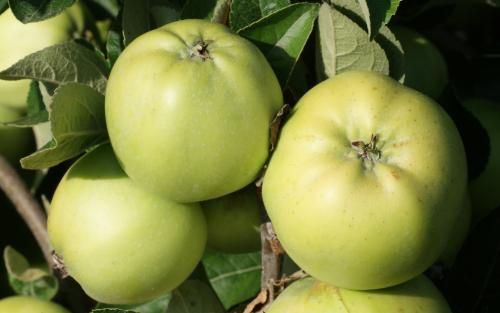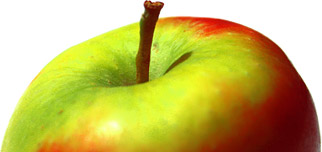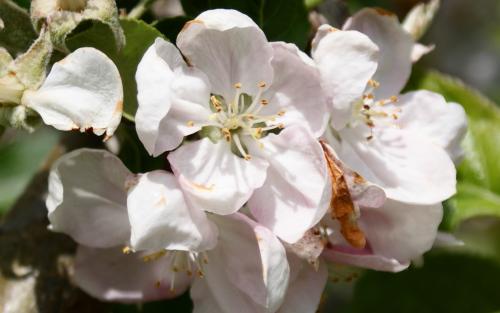
Keswick Codlin pre-dates the classic Victorian period of English apples. According to Victorian pomologist Robert Hogg writing later in the 19th century, it was first found growing as a seedling tree in a rubbish heap at Gleaston Castle near Ulverston at the southern tip of the English Lake District, in the 1790s. A local nurseryman from the nearby town of Keswick, John Sander, propagated it and helped establish it.
Keswick Codlin rapidly established itself as a very early season culinary apple with a good juicy acidic flavour. It readily cooks down to a sweet puree.
Keswick Codlin continues to be a popular garden variety to this day. Its success rests on two factors. Firstly its excellent flavour, early in the season when there is not much else about. Secondly, it is one of the more foolproof apple trees for the gardener, readily succeeding in damp climates with short growing seasons, and a reliable and usually heavy cropper.
Keswick Codlin apple identification images
All images copyright Orange Pippin unless otherwise stated.
USDA identification images for Keswick Codlin
The identification paintings in the USDA Pomological Watercolor Collection span the years 1886 to 1942.
Citation: U.S. Department of Agriculture Pomological Watercolor Collection. Rare and Special Collections, National Agricultural Library, Beltsville, MD 20705.
Offspring of this variety
- Chestnut Crab(distant descendant)
- Emneth Early
See also
- Dog's Snout - Dog's Snout has some visual similarity with Keswick Codlin.
Visitor reviews
- 20 Aug 2025All true. Plus, it’s the only variety in my garden that isn’t plundered by rats (I live in the country next to open fields.)
- 04 Nov 2016 SUSSEX, United KingdomGrandad had one of these and always ate the fruit straight from the tree, peeling it with his penknife. Now I have one and in November, enjoying the crisp, sharp flavor with grandchildren. It suffers from superficial fungus spot on the skin but we still enjoy the fruit.
- 08 Oct 2015 DEVON, United KingdomI planted this variety about 12 years ago. It's still hanging on the tree now (mid October - SW England) so for us it's not that early. We love it as a simple puree with creammmmm!
- 01 May 2015 SOUTHLAND, New ZealandMy tree is 3 years old and I was very happy to get my first apple this year. Only one! This tree was given to me as a gift from my parents when I bought my first home in NZ. I grew up opposite Gleaston Castle where it was found growing on a rubbish dump so this variety has sentimental value for my family and provides a connection to "home". There is a fantastic heritage orchard project run through our local environment centre http://www.sces.org.nz which sources trees from old homesteads in the area which would have been brought by early settlers and carries them on for future generations.
- 17 Oct 2010 SHROPSHIRE, United KingdomWhen we moved into our home 56 years ago, Sylvia, my late wife and I inherited a Victorian garden of ? acre that included about 8 apple trees, some of which still survive. One of which has been identified as the distinctive Keswick Codlin, always with a ridge down one side, sometime continuing right around. That tree,in spite of appearing on our detailed map of 1884 still produces fruit each year,as do three others of different species.
- 08 Jul 2010 BEDFORDSHIRE, United KingdomI guess this must be our Codlin, which keeps well in our eaves cupboard. We had some left 2 weeks after Easter this year and can see the next crop is a good one too.
- 26 Nov 2009 DERBYSHIRE, United KingdomI used to live in Lancaster. From looking at this web site and others, I'm pretty sure this was the variety of apple tree in our garden there. Great in pies and you could eat the ripest ones straight from the tree. Wouldn't mind tasting one again!
- 06 Jul 2009 CUMBRIA, United KingdomSharp intense apple flavour. Cooks to a pulp. Ideal for pies. Very easy, trouble free tree which is partially self fertile.
- 04 Oct 2008 BINFIELD HEATH, OXFORDSHIRE, United Kingdomis this the one with a crease down one side? I remember it from my Grandmothers garden in Bath many years ago.
- 18 Sep 2008 BANBURY, United KingdomI agree with the other comments here. We inherited a Keswick Codlin when we moved here 40 years ago, only we called it the 'mushroom tree' because of its shape, not knowing its variety until years later.It has fallen down three times, to differing degrees.and been jacked up as much as we could. We feared the most recent time would be terminal, its trunk being almost right down on the ground,and many of the roots out of soil. But no,3 years on it's fruiting brilliantly. Takes up a lot of space, but so much easier to pick! Wonderful old friend.
- 15 Sep 2008 HINCKLEY, LEIECSTERSHIRE, United KingdomI absolutely adore these as eating apples - they're grown organically at our local farm from where we buy our fruit and veg: Willow Farm run by the Rickard family in Congerstone, Warwickshire. They're too delicious to reserve for cooking only, and are the perfect apple combination of crisp, sharp and snappy - a bit of an eye-waterer!
- 09 Jan 2008 WORCESTER, United KingdomThis apple is one of the flavours of my childhood in Worcester, for eating from the tree and cooked. Our family inherited a mature Keswick tree and another just used for cooking when we bought an inner city terrace.
- 03 Aug 2007 United KingdomVery good apple for crumble and it fluffs up well with just a hint of water.
Tree register
United States
- Jo Elsmore in BLOORS,
United Kingdom
- Alex Webb in Cumbria, KENDAL
- Andrew Auld in Matlock, DERBYSHIRE
- Andrew Grant in York, NORTH YORKSHIRE
- Andy Chaplin in Sheffield, SOUTH YORKSHIRE
- Angela Gatland in Harrietsham, KENT
- Claire in LANCASTER, LANCASHIRE
- Clare Burrows in Bodorgan, ANGLESEY
- Darren T in MANCHESTER, GREATER MANCHESTER
- Dave Hoare in HADDENHAM, BUCKINGHAMSHIRE
- David &Amp;Amp;Susan Findlay in Nr Tain, ROSS SHIRE SCOTLAND
- David Briggs in Warwick, WARWICKSHIRE
- David Goodall in Wetherby,
- Freyja Burrill in Kings Meaburn/ Penrith, CUMBRIA
- James Kidd in Hightae, DUMFRIES AND GALLOWAY
- Jillian Tovey in Penrith, CUMBRIA
- John Sedgwick in Cockermouth, CUMBRIA
- Karen Guthrie in Coniston, CUMBRIA
- Lenore Greensides in Beverley, EAST YORKS
- Lindsay Barnes in Penrith, CUMBRIA
- Mariska Van Loenen in Aberdeen, ABERDEENSHIRE
- Nick in Clynderwyn, WALES
- Nick Burrows in Doncaster, NORTH YORKSHIRE
- Nick Burrows in Helmsley, NORTH YORKSHIRE
- Owen Roberts in Reepham, NORFOLK
- Paul Mckean in Southport, MERSEYSIDE
- Ralph Weston in Aston Clinton, BUCKS
- Rob Muir in Mossley, TAMESIDE
- Sally Leszczynski in Banbury, OXFORDSHIRE
- Steve Sim in Grange Over Sands, CUMBRIA
- Sue Fawcett in Pocklington, York, YORKSHIRE
- Terry Smith in Huntingford, DORSET
France
- David Marshall in Pechabou, HAUTE GARONNE
- Jeff Soens in PORT D'ENVAUX, FRANCE
Ireland
- Matt Steele in Blacklion, COUNTY CAVAN
Italy
- Judith Mackin in Pantasina, IMPERIA
New Zealand
- Giles in HAMILTON, WAIKATO
- Kirsty Lewis in Invercargill, SOUTHLAND
Spring blossom records for this variety
2018 season
- 8th May 2018 - tree owned by Paul in Southport, United Kingdom
2016 season
- 10th May 2016 - tree owned by Paul in Southport, United Kingdom
2015 season
- 15th May 2015 - tree owned by Lindsay in Penrith, United Kingdom
- 9th May 2015 - tree owned by Paul in Southport, United Kingdom
2014 season
- 10th May 2014 - tree owned by Paul in Southport, United Kingdom
- 10th May 2014 - tree owned by Paul in Southport, United Kingdom
2013 season
- 11th May 2013 - tree owned by Paul in Southport, United Kingdom
2012 season
- 15th May 2012 - tree owned by David in Nr Tain, United Kingdom
- 30th April 2012 - tree owned by Lenore in Beverley, United Kingdom
Record your blossom dates in our Fruit Tree Register - more >>.
Harvest records for this variety
2016 season
- 3rd week September 2016 - tree owned by Matt in Blacklion, Ireland
2015 season
- 3rd week September 2015 - tree owned by Paul in Southport, United Kingdom
2012 season
- August 2012 - tree owned by Lenore in Beverley, United Kingdom
2011 season
- 3rd week September 2011 - tree owned by Andrew in Matlock, United Kingdom
2010 season
- September 2010 - tree owned by Freyja in Kings Meaburn/ Penrith, United Kingdom
2009 season
Origins
- Species: Malus domestica - Apple
- Parentage: Unknown seedling
- Originates from: Ulverston, Lake District, England, United Kingdom
- Introduced: Early 19th century
- Developed by: John Sander, a nurseryman from Keswick
- UK National Fruit Collection accession: 2000-053
Identification
- Country of origin: United Kingdom
- Period of origin: 1800 - 1849
- Flower colour: White
- Leaf colour: Green
- Annual cycle: Deciduous
Using
- Picking season: Early
- Keeping (of fruit): 1 week
- Flavour quality: Very good
- Flavour style (apples): Sharper
- Cooking result: Puree
- Discoloration of fruit: Oxidising
- Cropping: Heavy
- Fruit persistence: Normal ripening
- Food uses: Culinary
- Food uses: Juice
- Food uses: Traditional cooker
- Picking period: mid-August
- Wildlife: RHS Plants for Pollinators
Growing
- Gardening skill: Beginner
- Flowering group: 2
- Pollinating others: Average
- Ploidy: Diploid
- Vigour: Average vigour
- Bearing regularity: Biennial tendency
- Fruit bearing: Spur-bearer
- Attractive features: Attractive flowers
- Self-fertility: Partially self-fertile
Climate
- Climate suitability: Temperate climates
- Climate suitability: Mild damp climates
- Summer average maximum temperatures: Cool ( 20-24C / 68-75F)
- Summer average maximum temperatures: Cold (< 20C / 67F)
Other qualities
- Disease resistance: Good
Where to buy trees
The following tree nurseries offer Keswick Codlin apple trees for sale:
- Orange Pippin Fruit Trees (UK) United Kingdom
Keswick Codlin apple trees - Keepers Nursery
United Kingdom More >>
Where to buy fresh fruit
The following orchards grow Keswick Codlin:
United States
Iowa
- Wilson's Orchard, Iowa City
United Kingdom
England - midlands
- Walsgrove Farm, Worcester
England - north
- Holly Mount Orchard, Bury
- Coulton Mill, York
Canada
British Columbia
- Salt Spring Apple Company, Salt Spring Island
Australia
Victoria
- Heritage Fruits Society, Fairfield
References
- Apples of England (1948)
Author: Taylor


